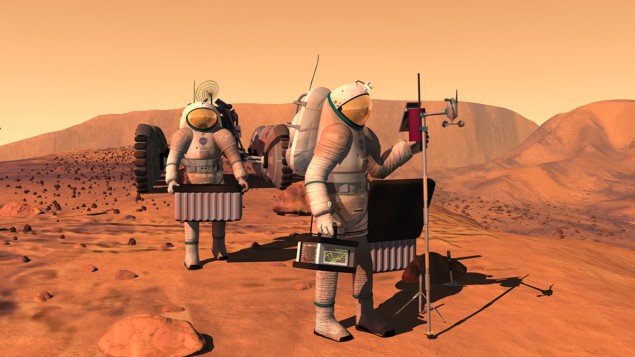Ian Randall reviews Space 2069: After Apollo – Back to the Moon, to Mars, and Beyond by David Whitehouse

As a consummate fan of televised science fiction, it was inevitable that the task of reviewing a book entitled Space 2069 would first bring to my mind the cult 1970s series of almost the same name (Space 1999). Having finished journalist David Whitehouse’s latest book – which bears the subtitle After Apollo – Back to The Moon, to Mars and Beyond – I found myself musing, however, on the opening narration of a quite different franchise. Space, as so many episodes of TV’s Star Trek have reminded us, is the final frontier; one in which we have unparalleled potential to go “where no-one has gone before”. In this reviewer’s opinion, the same, alas, can no longer be said of publishing on the subject. When it comes to writing about our past and future exploration of the solar system in particular, the pioneer days are over, the wagon trains have arrived en masse, and to stand out on the now crowded shelves, newcomers really need to show they have access to an untapped motherlode.
It is for this reason, I think, that I found myself – while not disappointed – generally unaffected by Whitehouse’s serviceable new offering, a sequel to his widely acclaimed bestseller, Apollo 11: the Inside Story. As the US renews its interest in picking up crewed lunar exploration where the Apollo programme left off, and China continues to build the steady momentum of its own space programme, Whitehouse knowledgeably (if predictably) imagines our next 50-ish years of humans travelling back to the Moon; on to the red planet; and beyond. The book alternates between imagining the voyages of future space missions, and an encyclopaedic account of the past missions that will eventually make such journeys possible.
The book includes a number of fun titbits. For example, I was relieved to hear that coffee and hops would grow well on Mars, and was intrigued by the notion that the Moon could be used to house a backup seed bank and master library, in the event the Earth is struck by a global cataclysm. I was also amused to learn that astronauts refer to the impact of low gravity as “puffy face, bird legs”.
But some other areas were missed possibilities for engaging tangents, and left me wanting more. For example, I was keen to hear details about the “mutiny” of the Apollo 7 crew – surely it did not just involve “talking back” to ground control, as suggested? And I wanted a real discussion of the experiments that have been conducted into the psychological impacts of a simulated Mars voyage. Whitehouse mentions the longest such test – Russia’s 520-day-long Mars500 – but neglects the more captivating Sphinx-99 mission, whose chaos peaked with a fist fight and one “astronaut” locking herself away from most of the rest of the crew out of sheer frustration.
Whitehouse certainly has a formidable command of the history of space exploration, but in parts Space 2069 lets its overarching narrative slip into obscurity, behind the intense recitation of historical particulars. The most prominent example comes early on in the work, in a chapter that opens with the observation that, unlike the Earth, the geography of the Moon is unfamiliar. “At the time of Apollo many offices and children’s bedrooms had a poster of the Moon. They are seldom seen now,” Whitehouse writes, adding that “the names of the major craters and ‘seas’ are a mystery to many”.

A new look at our old Moon
As if to prove this point, the following 11 pages take the reader on a journey across the lunar landscape, from one such unheard-of locale to the next. With, perhaps, the aid of a map and plenty of pictures, this gambit might have worked well to engage the reader with the Moon’s alien geographies. Instead, the frenetic array of lunar placenames – Langregous, Medii, Aristarchus, Riccioli, Morteus and so on – is overwhelming and self-defeating without visuals to help. In a similar vein, a later chapter called “22 images” is curious in showing exactly none.
In contrast, the more futurist sections of the work suffer from almost the opposite problem. The voyages of such imagined craft as the James Caird II – the first crewed vessel to orbit Mars in 2039 – are engaging (to the extent that the book could easily have been hung on such pegs alone) but would have benefited from more explanation as to the research grounding such narratives.
Space 2069 is rich, topical and informative. But so are the three other books on the same topic on my bookshelves
I should confess that a small portion of my mild disaffection with Space 2069 began even before the book’s preface, and manifests from how Whitehouse chooses to present himself in the acknowledgement’s section: as someone with personal relationships with Arthur C Clarke, Carl Sagan and Patrick Moore. Perhaps this was meant to establish his credentials, but for me, this name-dropping was ostentatious and unrelatable. I should prefer to have been informed of his background in astrophysics (a fact that I do not recall being mentioned at any point in the work) or instead introduced to his personality and humour as a writer.
This returns me to my opening point. Space 2069 is a perfectly agreeable book. It is rich, topical and informative. But so are the three other books on the same topic on my bookshelves. Without that special something – whether it be a fresh perspective, an unexpected framing device, or a particularly compelling or accessible authorial voice – there is little to commend one over the others.
- 2020 Icon Books £16.99hb 304pp



